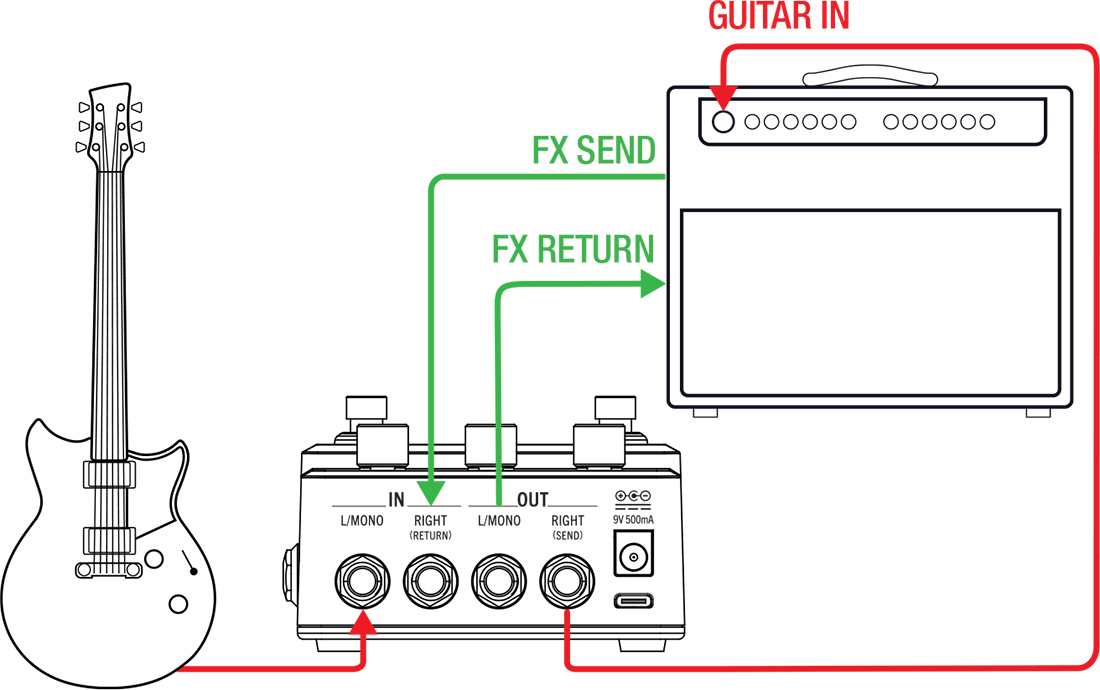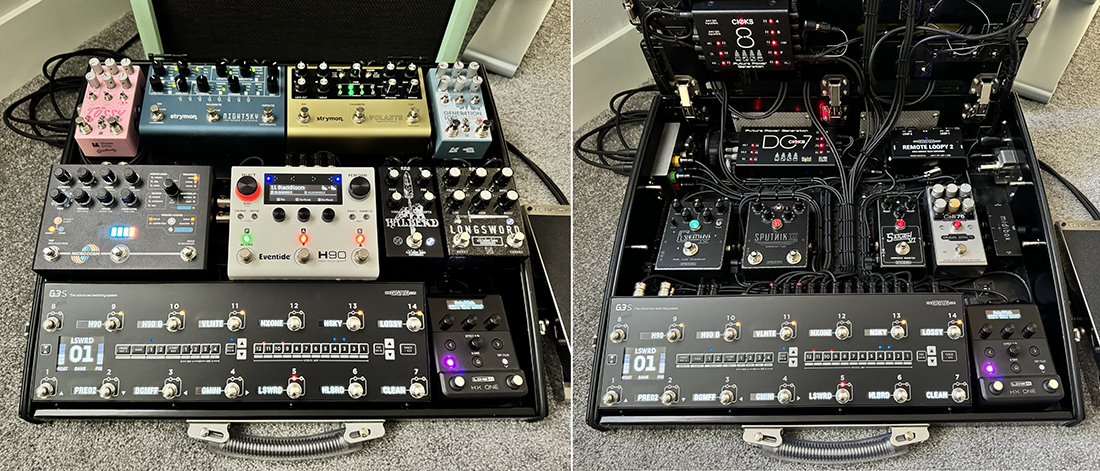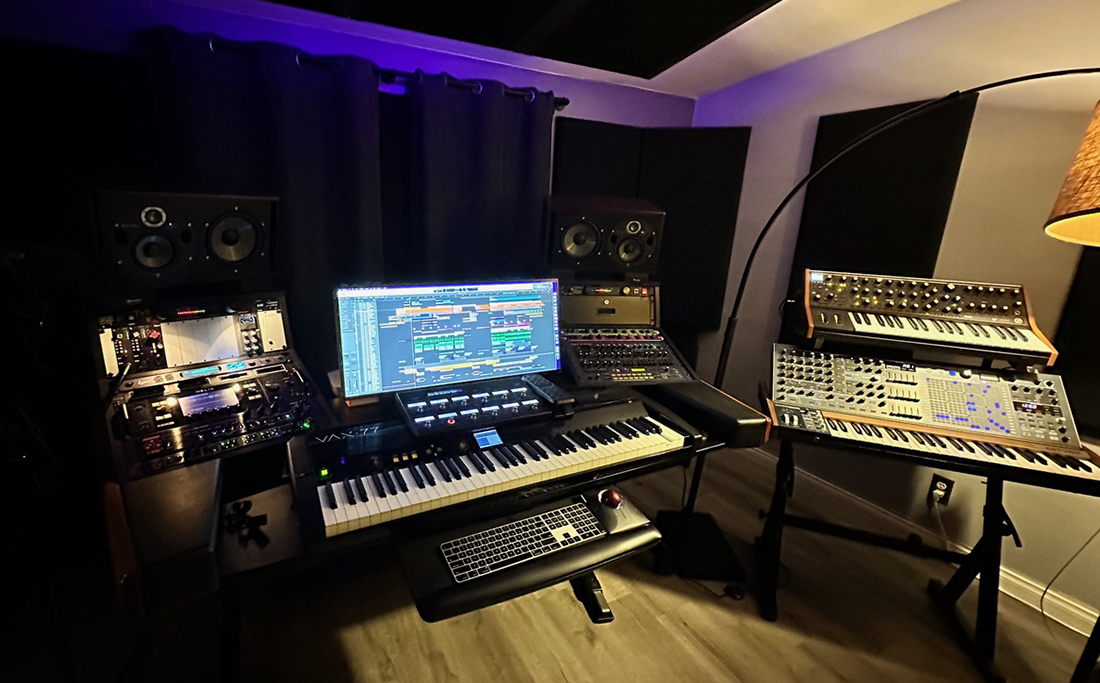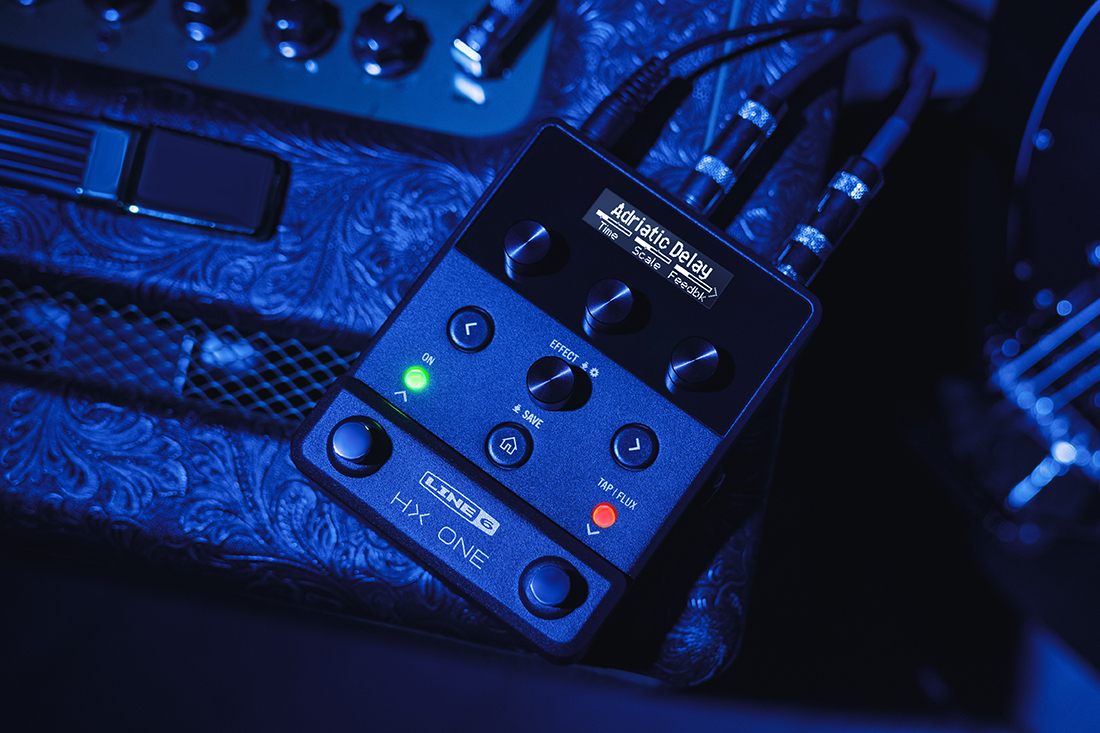The Making Of HX One
by Eric Klein, Anthony Taglianetti
Angela Heine, our Web Production Manager, caught up with Eric Klein and Anthony Taglianetti to talk about the creation of HX One.
Angela: Would you give some insight into how the product ideation happened for the HX One?
Eric Klein: M5 [Stompbox Modeler, 2011] started out as this dark horse slow burn. Nashville picked it up about seven, eight years ago and by word of mouth, it ended up on tons and tons of session musicians’ pedalboards over the years. M9 was also very popular, but M5 seemed to stick even better because of its size. Since then we’ve released HX Effects, which is much more powerful and flexible with new HX models, effects, and features, but M5s were still this familiar, easy to use, “I-don’t-wanna-deal-with-multi-effects-just-give-me-one-pedal-that-has-everything-and-let’s-go.”
M5 was one of the first projects I worked on when first starting at Line 6, so it’s always given me this sorta’ warm and fuzzy feeling. So we wanted whatever might replace M5 to not just bring it into the world of Helix, but keep that magic.
Angela: Many reading here might be familiar with Line 6 IdeaScale, where customers can provide input into what they would love to see in a new product. Did IdeaScale help at all?
Eric: It did. There were a lot of user requests for a new M5 but the loudest requests we got came from artists, session musicians, guitar techs, and tour managers. They said, “Hey, we’d really love a smaller, updated, more powerful M5 with all the Helix love.” That was the initial germ, but it was also a clear natural progression of our product road map.
Angela: Speaking of guitar pedal rigs, let’s talk pedalboards. HX One was really developed to help make someone’s pedalboard more powerful and useful. Can you share how HX One does that?
Anthony Taglianetti: The number one thing is versatility. Whether you’re trying to keep your pedalboard from getting out of control (we’ve all been there), or if you don’t want to buy a dedicated ring mod, flanger, or octave fuzz for the one song that needs it, HX One can be whatever you want it to be. HX One can also route itself before or after your other pedals. If you want to use a polyphonic pitch shifter in one preset and a lush reverb in the other, you can set up HX One in four cable method and route all your other pedals in its loop. And then per preset, you can choose whether HX One comes before or after those effects.

That to me is one of the most important features, because for a pedal that has so much range, you don’t have to compromise on where it lives in your signal chain. You get to choose whether it’s pre or post anything on your board.
Angela: Anthony, you shared a picture of your pedal board. Would you tell us more about it.
Anthony: It’s a Schmidt Array pedalboard, which has a hinged top shelf. I keep all the set-and-forget effects underneath, mostly different flavors of dirt and compression, along with all the power and audio cabling. The top board is a variety of delays, reverbs, and special effects. My workflow is generally getting an SOS loop going on either the Volante or Microcosm, processing it with other effects and then sampling the output in my DAW. HX One is mostly on pitch-shifting duty. I use the PolyPitch and PolySustain effects a lot, but lately I’ve been also using the newer Dynamic Reverbs. The Dynamic Hall and Dynamic Plate reverbs are giving some of my favorite reverb plug-ins a run for their money…

Angela: And Eric, you shared a photo of your studio. Do you use HX One in the studio?
Eric: I do. The primary Line 6 product I use is Helix Native but there’s something just immediate about having a pedal right there. And an expression pedal’s always connected, which I think is really important—just the ability to morph between two settings of the same effect, so your sound isn’t so static. Even subtle changes make a big difference and help keep the ear engaged.
It’s something that artists have done since the heyday of DL4 [delay modeler pedal] where every parameter can have completely different settings at your expression pedal’s heel and toe positions. It’s especially cool with tape delays where you have full control over self-oscillation squeals or atmospheric space noises. Sure, you could certainly pull that off with automation lanes in your DAW, but it’s not nearly as fun and it doesn’t inspire your performance while recording like it can with a real stompbox and expression pedal.

Angela: I know you kind of already touched on this, but I feel like pedal board real estate is always talked about. Can you expand on how HX One helps with that?
Anthony: For sure, pedalboard real estate is always at a premium… You’ve got a limited amount of space to work with and only so many outputs on your power supply, so any pedal on your board needs to pull its weight. HX One has over 250 effects, so it can help minimize the number of pedals you need to have on your board.
HX One also has a built-in expression controller on its second footswitch called Flux. Many effects come to life when manipulated in real time by an expression pedal; it adds more depth to the performance, where the effect becomes a part of what you’re playing, not just some static thing slathered on top of it…
Most expression pedals are large, only have a few outputs, and may not be compatible with all of your effects. With expression built directly into HX One, you don’t have to worry about that. It’s really easy to use, and in some ways, more powerful than using your foot with a regular expression pedal. For example, I can tempo sync a Flux movement so that HX One gradually adjusts the Wet mix of a reverb over a span of four bars.

You just hold down the tap tempo foot switch for a few seconds, it turns white and now automatically that foot switch is going to ramp between two sets of parameters and give you a completely different experience when you’re using that effect.
Eric: Flux is so much fun. But I think another thing that might be lost on people is how great HX One actually sounds. So many of its effects straight up rival—and in some cases surpass—dedicated pedals that guitarists and bassists are already spending hundreds of dollars on. For one effect.
There’ll always be some debate, but there’s sort of a consensus that as far as hardware goes, our polyphonic pitch shifting is better than anything else out there. The fact that we have all of these different polyphonic algorithms, plus 240 or 250 effects on top of that make it a pretty crazy value proposition as well.
But my favorite thing, and this might be on a tangent, but if you’re a beginner and aren’t yet sure what kind of effects you like, HX One is the perfect learning platform. If you think “Hey, I love the fuzz from this record, but it sounds nothing like the fuzz from this other record. What’s going on with fuzzes?” Or “Hey, what’s the difference between flangers and phasers?” Or someone who’s been playing for years still might not know whether they prefer silicon, LED, or germamium circuits. Things like that. HX One is a great way to learn what type of effects you like. Then if you really want to dig into the rabbit hole, you can go snag a couple of your favorite pedals and then use them in conjunction with HX One.
Angela: You kind of read my mind because I was thinking about the people who hear that there are 250 effects and they think “Well, I don’t need 250 effects. Why would I want that?”
Anthony: I mean, I have a closet full of guitar pedals. When you’re searching for a particular guitar tone, it’s super easy to go down that rabbit hole. Your favorite band may use a specific pedal but it may not work well with your technique, guitar, or amplifier. You end up making these purchases that you either bond with or don’t. HX One can save you some time and frustration by showing how a particular effect could fit your playing style and rig.
Angela: I think that leads into the modeling. Line 6 has spent decades in innovative modeling and now it’s in the super small package. Can you share the progress to that?
Eric: Some of the effects are models, but not all. With distortions, compressors, etc., we disassemble the original pedals or rack gear, measure every single component, and then recreate those components and their sometimes complex behaviors with what effectively is a massive toolbox of DSP LEGOs. Time-based effects like reverbs, delays, and certain mods—you can’t technically model them from other pedals. You have to create them from scratch with deep understanding and a lot of complex math. Our DSP team is extremely talented and they come up with all sorts of really unique sounds.
For example, Dan Godlovich is on our team from Canada and he’ll hit us up and ask “Hey, what do you think about this type of effect?” And it ends up being this just wildly imaginative source of inspiration like Glitch Delay or Retro Reel or Shuffling Looper. Things that are like, “Wow, that’s cool enough to be its own pedal.” In the end, it has as much sound design curation and love—not to mention the same amount of DSP as (or more DSP than)—any dedicated $400 pedal. Times 250.
Angela: Yvette Young did a really powerful demo of HX One when it was released. Can you share your thoughts on that video?
Eric: The first time I saw that video, my jaw dropped and I sent it to everybody I knew.
Anthony: Yeah, that’s a great video.
Eric: She did actually multitrack, I think, two effects on top of each other. It’s the Shuffling Looper, but she uses it in such an artistic and creative way. You can see how much fun Yvette’s having and it’s infectious. It straight inspired me to remix a friend’s band using a similar technique, but with a tiny fraction of the skill.
Angela: Anything you wanted to say about HX One that wasn’t said before we go?
Eric: We very easily could’ve said “Hey, let’s split HX One into like 15, 20 different pedals and make more money.” But that didn’t sit right with any of us. It felt kinda greedy and made more sense to give everybody everything, as long as we weren’t sacrificing too much ease-of-use.
Angela: Thanks everyone for coming to learn a bit about HX One, if you are currently using HX One on your pedalboard or in your studio, please share below some of your favorite uses for it.

Eric Klein is Chief Product Design Architect at Yamaha Guitar Group, trolls several gear forums via the handle Digital Igloo, and if you ask nicely, will show you nine thousand pictures of his two dogs, Bill&Ted and Paddles.

Anthony Taglianetti is a product owner and stompbox afficionado at Yamaha Guitar Group, who roams the Pacific Northwest alongside with his four dogs – Bella, Bowie, Riley, & Gizmo, lost in reveries of fuzz, delay, and reverb.





Leave a Reply
You must be logged in to post a comment.